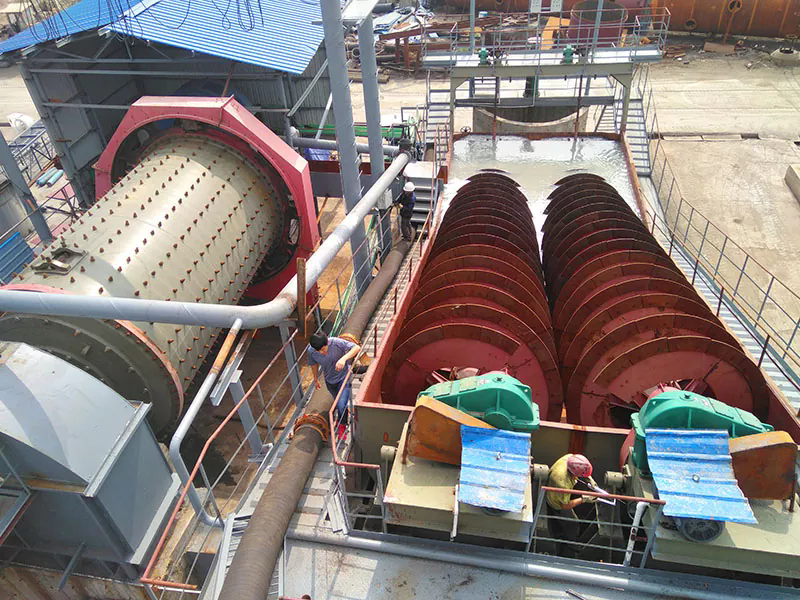 English
English Español
Español  Português
Português  русский
русский  Français
Français  日本語
日本語  Deutsch
Deutsch  tiếng Việt
tiếng Việt  Italiano
Italiano  Nederlands
Nederlands  ภาษาไทย
ภาษาไทย  Polski
Polski  한국어
한국어  Svenska
Svenska  magyar
magyar  Malay
Malay  বাংলা ভাষার
বাংলা ভাষার  Dansk
Dansk  Suomi
Suomi  हिन्दी
हिन्दी  Pilipino
Pilipino  Türkçe
Türkçe  Gaeilge
Gaeilge  العربية
العربية  Indonesia
Indonesia  Norsk
Norsk  تمل
تمل  český
český  ελληνικά
ελληνικά  український
український  Javanese
Javanese  فارسی
فارسی  தமிழ்
தமிழ்  తెలుగు
తెలుగు  नेपाली
नेपाली  Burmese
Burmese  български
български  ລາວ
ລາວ  Latine
Latine  Қазақша
Қазақша  Euskal
Euskal  Azərbaycan
Azərbaycan  Slovenský jazyk
Slovenský jazyk  Македонски
Македонски  Lietuvos
Lietuvos  Eesti Keel
Eesti Keel  Română
Română  Slovenski
Slovenski  मराठी
मराठी  Srpski језик
Srpski језик
What Makes Spiral Classifiers Essential in Modern Mineral Processing?
2025-11-11
In modern mineral processing, achieving high-efficiency classification is crucial for optimizing ore beneficiation and reducing energy consumption. Spiral classifiers have emerged as a reliable solution for separating fine particles from coarse materials in wet grinding operations. Designed to meet diverse industrial demands, these devices are widely used in mining, metallurgy, chemical, and construction material industries.
The main focus of this article is to provide a deep understanding of Spiral Classifiers’ functionality, highlight their operational advantages, and discuss future developments that could transform their applications. Detailed product specifications are provided to help buyers make informed decisions and optimize plant efficiency.
What Are Spiral Classifiers and How Do They Operate?
Spiral classifiers are mechanical devices used for classifying and separating ore particles based on size and density. They typically consist of a sloped trough, a rotating spiral blade, a drive mechanism, and a discharge system. By continuously lifting coarser particles and allowing finer ones to overflow, spiral classifiers efficiently sort material for downstream processing, such as ball mills or flotation systems.
How Spiral Classifiers Work:
-
Ore slurry feeding: Ground ore mixed with water forms a slurry that enters the classifier’s feed point.
-
Settling process: Coarser particles settle at the bottom due to gravity, while fine particles remain suspended.
-
Spiral rotation: The spiral blade lifts the settled coarse particles to the discharge point.
-
Separation and overflow: Fine particles overflow at the end of the trough, ready for further processing.
This operational principle ensures precise separation, reduces material losses, and maintains a stable feed for subsequent grinding or processing stages. Spiral classifiers can handle a variety of ores, including iron, copper, gold, and non-metallic minerals.
Product Parameters of Spiral Classifiers
| Parameter | Description |
|---|---|
| Model | EPIC-SC Series |
| Feed Size | ≤30 mm |
| Discharge Size | 0.074–0.5 mm |
| Capacity | 1–300 t/h |
| Spiral Diameter | 300–1500 mm |
| Spiral Rotation Speed | 20–45 rpm |
| Trough Length | 3–12 m |
| Power Requirement | 1.5–22 kW |
| Material | High-strength steel, corrosion-resistant lining |
| Application | Mineral separation, sand classification, slurry thickening |
This table provides a clear reference for selecting the appropriate Spiral Classifier model based on ore type, processing capacity, and operational requirements.
Why Are Spiral Classifiers Advantageous for Mineral Processing Plants?
Spiral classifiers offer several advantages over alternative classification methods, making them a preferred choice for many mining operations. Their benefits can be summarized as follows:
Advantages:
-
High Classification Efficiency: By accurately separating fine and coarse particles, spiral classifiers ensure downstream equipment operates under optimal conditions.
-
Stable Operation: Designed to handle fluctuating feed rates and variations in slurry density, spiral classifiers maintain consistent performance with minimal downtime.
-
Durable Construction: Made with high-strength, corrosion-resistant materials, these devices offer long service life even under abrasive conditions.
-
Energy Saving: Spiral classifiers consume less power compared to mechanical screens, reducing operational costs.
-
Low Maintenance: Simplified design with fewer moving parts minimizes maintenance needs and improves plant uptime.
-
Versatility: Suitable for diverse industries, including mining, metallurgy, chemical processing, and construction material production.
Practical Applications:
-
Ore Dressing: Classification of iron, gold, copper, and non-ferrous ores for ball mill operations.
-
Sand Washing: Sorting sand by particle size for construction purposes.
-
Slurry Thickening: Concentrating fine particles in slurry for efficient water recovery and reuse.
The combination of efficiency, durability, and operational stability makes spiral classifiers an indispensable tool in modern mineral processing.
How Are Spiral Classifiers Evolving for the Future?
The future of Spiral Classifiers lies in improving efficiency, adaptability, and automation. As mineral processing plants face increasing demand for higher throughput and stricter environmental compliance, spiral classifier technology is evolving in the following ways:
Future Trends:
-
Automation and Smart Monitoring: Integration with digital monitoring systems allows real-time adjustments to spiral speed, slurry density, and feed rate, enhancing classification accuracy.
-
Enhanced Wear Resistance: Advanced materials, including wear-resistant alloys and rubber linings, extend equipment lifespan and reduce maintenance costs.
-
Energy Efficiency Improvements: Optimized spiral designs and variable-speed drives reduce energy consumption while maintaining classification performance.
-
Modular Designs: Modular spiral classifiers can be customized for specific plant layouts, making installation and maintenance more flexible.
-
Eco-Friendly Solutions: Reduced water consumption and improved slurry recirculation systems support sustainable operations.
These developments indicate that spiral classifiers will continue to play a critical role in mineral processing while addressing operational efficiency and environmental sustainability.
Frequently Asked Questions (FAQs) About Spiral Classifiers
Q1: How does particle size affect the efficiency of a spiral classifier?
A1: Particle size significantly impacts classification efficiency. Coarser particles settle faster, while fine particles may remain suspended longer. Spiral classifiers must be adjusted for feed size, slurry concentration, and spiral rotation speed to ensure optimal separation and prevent overflow or misclassification. Proper calibration ensures the downstream ball mills and flotation systems receive consistent feed, enhancing overall plant performance.
Q2: What maintenance practices ensure long-term performance of a spiral classifier?
A2: Regular maintenance includes checking the spiral blade for wear, inspecting the drive system, and ensuring the trough remains free from obstructions. Lubrication of moving parts and monitoring slurry pH and abrasive content can reduce corrosion and wear. Scheduled inspections help detect early signs of damage, prolonging service life and minimizing unexpected downtime.
Spiral classifiers are integral to efficient mineral processing, providing precise separation, operational stability, and adaptability across various industrial applications. By understanding their parameters, advantages, and future developments, operators can make informed decisions to enhance productivity and reduce costs. For reliable and high-performance Spiral Classifiers, EPIC provides a comprehensive range of models designed to meet diverse industrial needs.
Contact Us to explore EPIC Spiral Classifiers for your mineral processing projects and optimize your operations with advanced classification technology.





